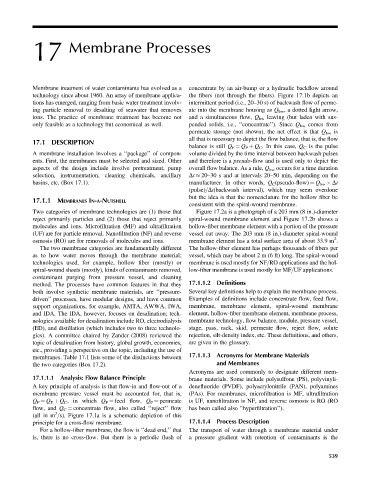Page 584 - Fundamentals of Water Treatment Unit Processes : Physical, Chemical, and Biological
P. 584
17 Membrane Processes
Membrane treatment of water contaminants has evolved as a concentrate by an air-bump or a hydraulic backflow around
technology since about 1960. An array of membrane applica- the fibers (not through the fibers). Figure 17.1b depicts an
tions has emerged, ranging from basic water treatment involv- intermittent period (i.e., 20–30 s) of backwash flow of perme-
ing particle removal to desalting of seawater that removes ate into the membrane housing as Q bw , a dotted light arrow,
ions. The practice of membrane treatment has become not and a simultaneous flow, Q bw leaving (but laden with sus-
only feasible as a technology but economical as well. pended solids, i.e., ‘‘concentrate’’). Since Q bw comes from
permeate storage (not shown), the net effect is that Q bw is
all that is necessary to depict the flow balance, that is, the flow
17.1 DESCRIPTION
balance is still Q F ¼ Q P þ Q C . In this case, Q C is the pulse
A membrane installation involves a ‘‘package’’ of compon- volume divided by the time interval between backwash pulses
ents. First, the membranes must be selected and sized. Other and therefore is a pseudo-flow and is used only to depict the
aspects of the design include involve pretreatment, pump overall flow balance. As a rule, Q bw occurs for a time duration
selection, instrumentation, cleaning chemicals, ancillary Dt 20–30 s and at intervals 20–50 min, depending on the
basins, etc. (Box 17.1). manufacturer. In other words, Q C (pseudo-flow) ¼ Q bw Dt
(pulse)=Dt(backwash interval), which may seem overdone
but the idea is that the nomenclature for the hollow fiber be
17.1.1 MEMBRANES IN-A-NUTSHELL
consistent with the spiral-wound membrane.
Two categories of membrane technologies are (1) those that Figure 17.2a is a photograph of a 203 mm (8 in.)-diameter
reject primarily particles and (2) those that reject primarily spiral-wound membrane element and Figure 17.2b shows a
molecules and ions. Microfiltration (MF) and ultrafiltration hollow-fiber membrane element with a portion of the pressure
(UF) are for particle removal. Nanofiltration (NF) and reverse vessel cut away. The 203 mm (8 in.)-diameter spiral-wound
2
osmosis (RO) are for removals of molecules and ions. membrane element has a total surface area of about 33.9 m .
The two membrane categories are fundamentally different The hollow-fiber element has perhaps thousands of fibers per
as to how water moves through the membrane material; vessel, which may be about 2 m (6 ft) long. The spiral-wound
technologies used, for example, hollow fiber (mostly) or membrane is used mostly for NF=RO applications and the hol-
spiral-wound sheets (mostly), kinds of contaminants removed, low-fiber membrane is used mostly for MF=UF applications.
contaminant purging from pressure vessel, and cleaning
method. The processes have common features in that they 17.1.1.2 Definitions
both involve synthetic membrane materials, are ‘‘pressure- Several key definitions help to explain the membrane process.
driven’’ processes, have modular designs, and have common Examples of definitions include concentrate flow, feed flow,
support organizations, for example, AMTA, AWWA, IWA, membrane, membrane element, spiral-wound membrane
and IDA. The IDA, however, focuses on desalination; tech- element, hollow-fiber membrane element, membrane process,
nologies available for desalination include RO, electrodialysis membrane technology, flow balance, module, pressure vessel,
(ED), and distillation (which includes two to three technolo- stage, pass, rack, skid, permeate flow, reject flow, solute
gies). A committee chaired by Zander (2008) reviewed the rejection, silt-density index, etc. These definitions, and others,
topic of desalination from history, global growth, economies, are given in the glossary.
etc., providing a perspective on the topic, including the use of
membranes. Table 17.1 lists some of the distinctions between 17.1.1.3 Acronyms for Membrane Materials
the two categories (Box 17.2). and Membranes
Acronyms are used commonly to designate different mem-
17.1.1.1 Analysis: Flow Balance Principle brane materials. Some include polysulfone (PS), polyvinyli-
A key principle of analysis is that flow-in and flow-out of a denefluoride (PVDF), polyacrylonitrile (PAN), polyamines
membrane pressure vessel must be accounted for, that is, (PAs). For membranes, microfiltration is MF, ultrafiltration
Q F ¼ Q P þ Q C , in which Q F ¼ feed flow, Q P ¼ permeate is UF, nanofiltration is NF, and reverse osmosis is RO (RO
flow, and Q C ¼ concentrate flow, also called ‘‘reject’’ flow has been called also ‘‘hyperfiltration’’).
3
(all in m =s). Figure 17.1a is a schematic depiction of this
principle for a cross-flow membrane. 17.1.1.4 Process Description
For a hollow-fiber membrane, the flow is ‘‘dead end,’’ that The transport of water through a membrane material under
is, there is no cross-flow. But there is a periodic flush of a pressure gradient with retention of contaminants is the
539

